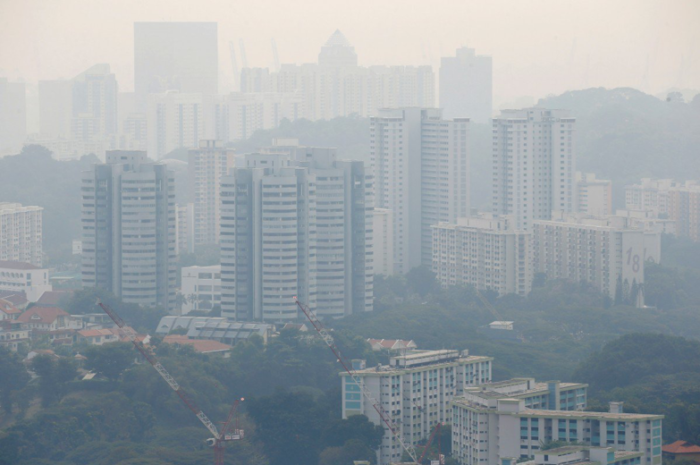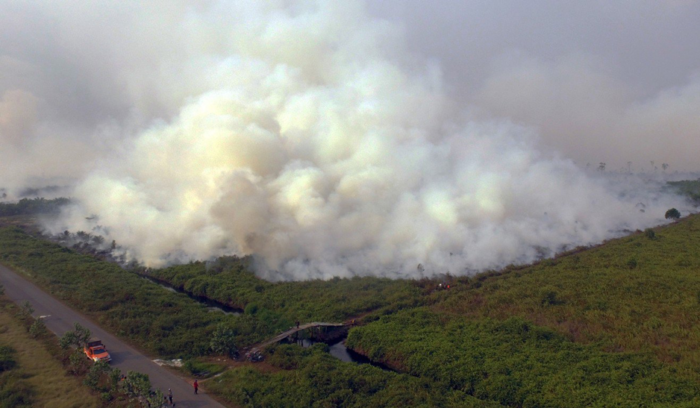Indonesian fires and haze
By Laura Kiely (@laurafkiely)- University of Leeds and UBoC
Emissions of smoke from peatland fires may have been underestimated, finds a new study from LEAF scientists at the University of Leeds.

Smoke from fire in Kalimantan, 18 September 2019. Photo: Fauzy Chaniago/The Associated Press
In the last few weeks thousands of peatland and forest fires have been burning across Sumatra and Kalimantan, two islands in Indonesia. Smoke from these fires causes haze across Singapore and Malaysia as well as areas of Indonesia, causing unhealthy levels of air pollution. Schools have been closed and residents are being advised to stay indoors.
Smoke from fires can affect the climate, reducing rainfall and warming the atmosphere. Poor air quality as a result of smoke can have a negative impact of health. Small particles emitted from fires (particulate matter < 2.5µm in diameter) can enter the lungs and blood stream, and have been associated with respiratory and heart problems.
One of the reasons emissions from Indonesian fires are so large is that many fires occur on peatland. Peat can burn underground and can smoulder for weeks after the surface fire has gone out. Peatland naturally remains wet, and does not burn. However, deforestation and drainage of peatlands, which have occurred across Indonesia in recent decades, dries the peatland making it more flammable and susceptible to fires.
Inventories of the emissions from fires are required to simulate the impacts of fires on climate change, air quality and to quantify the population exposure to poor air quality. There are large uncertainties associated with estimations of emissions from tropical peat fires, due partly to difficulties in determining the depth of the fires. This can depend on the depth of the peat, and the depth of the water level within the peat, as the fire is unlikely to burn past this level. While studies have been conducted on individual peat fires, there is little large-scale information on peat fires in Indonesia.

Haze in Singapore. Photo: Reuters
Another source of uncertainty in the emission from peat fires is the difference in peat at different locations. Peat fires in the tropics cause higher emissions than peat fires in Europe, but historically more studies have been conducted on European peat, meaning that these values are more likely to be used in emissions inventories.
In a new study, published in the journal Atmospheric Chemistry and Physics, we created a new dataset of emissions from peatland fires in Indonesia. We focused on the year 2015, which had the biggest fires in recent years.
We combined satellite data of fire hotspots and soil moisture with Indonesian specific measurements of fire emission factors. We used satellite information on soil moisture to control the depth we assumed the fires burned into the peat. By inputting our new emissions data into a regional air quality model, we were able to compare against real world measurements of smoke from across the region and demonstrate that our new dataset accurately simulates emissions.

Burning peatland in Kalimantan. Photo: EPA=EFE
We found that emissions of smoke from Indonesian peatland fires in 2015 were a factor 1.8 greater than other emissions inventories. A previous study estimated that the 2015 fires exposed 69 million people to unhealthy levels of air pollution. Our new work suggests that the impacts on air quality have been even greater.
Our study also estimated emissions of carbon dioxide from the fires. We estimated that the 2015 fires emitted 781 Tg of carbon dioxide. This value is similar to previous studies and confirms the large contribution of peatland fires to climate change – they emitted more carbon dioxide than emitted by all the fossil fuel burning in the European Union during the same period.
As Indonesian forests burn yet again, it is imperative that we work together to find solutions to control these fires and try to prevent future burning. Our next step is to work to provide updated information on the impact of fires on air quality across the region. With funding from the British Council’s Newton Fund Institutional Links Programme, part of the UK’s commitment to overseas aid, we are working with colleagues across Indonesia to develop new haze forecasting tools that will help warn at risk communities of unhealthy air.
Read the full study here:
Kiely, L., Spracklen, D. V., Wiedinmyer, C., Conibear, L., Reddington, C. L., Archer-Nicholls, S., Lowe, D., Arnold, S. R., Knote, C., Khan, M. F., Latif, M. T., Kuwata, M., Budisulistiorini, S. H., and Syaufina, L.: New estimate of particulate emissions from Indonesian peat fires in 2015, Atmos. Chem. Phys., 19, 11105–11121, https://doi.org/10.5194/acp-19-11105-2019, 2019.
